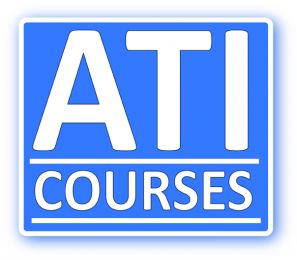ATI's Fundamentals of Radar Technology course
A three-day course covering the basics of radar, taught in a manner for true understanding of the fundamentals, even for the complete newcomer. Covered are electromagnetic waves, frequency bands, the natural phenomena of scattering and propagation, radar performance calculations and other tools used in radar work, and a "walk through" the four principal subsystems - the transmitter, the antenna, the receiver and signal processor, and the control and interface apparatus - covering in each the underlying principle and componentry. A few simple exercises reinforce the student's understanding. Both surface-based and airborne radars are addressed.
Course Outline:
-
- The basic nature of radar and its applications, military and civil
- Radiative physics (an exercise); the radar range equation; the statistical nature of detection
- Electromagnetic waves, constituent fields and vector representation
- Radar "timing", general nature, block diagrams, typical characteristics
- Scattering: Rayleigh point scattering; target fluctuation models; the nature of clutter
- Propagation: Earth surface multipath; atmospheric refraction and "ducting"; atmospheric attenuation
- Other tools: the decibel, etc. (a dB exercise)
- An example radar and performance calculations, with variations
- Overview: the role, general nature and challenges of each
- The Transmitter, basics of power conversion: power supplies, modulators, rf devices (tubes, solid state)
- The Antenna: basic principle; microwave optics and pattern formation, weighting, sidelobe concerns, sum and difference patterns; introduction to phased arrays
- Receiver: preamplification, conversion, heterodyne operation "image" frequencies and double conversion
- Signal processing: pulse compression
- Signal processing: Doppler-sensitive processing
- Airborne radar - the absolute necessity of Doppler processing
- Automatic detection and constant-false-alarm-rate (CFAR) techniques of threshold control
- Automatic tracking: exponential track filters
- Multi-radar fusion, briefly
- Course review, discussion, current topics and community activity
Speaker and Presenter Information
Robert T. Hill (LF-IEEE) was born in Iowa, 1935, received BS in EE 1957 and MS in EE 1967. An Air Force ground electronics officer (radar) 1958-1960, he then worked as an engineer tor the Navy Department in radar system development, 1960 until his retirement in 1988. Having begun teaching in 1975, he now teaches for several sponsors world wide. Since 1982 he has written the radar articles for the McGraw-Hill technical encyclopedia. Active in the IEEE, he was many years a member of its Radar Systems Panel and the Board of Governors of its AES Society. He remains active in radar conference planning of the IEEE and those societies around the world cooperating in such conferences. He resides with his wife of 55 years in Easton, Maryland, USA.Relevant Government Agencies
Air Force, Army, Navy & Marine Corps, Intelligence Agencies, DOD & Military, Office of the President (includes OMB), Dept of Energy, Dept of Health & Human Services, Dept of Homeland Security, Dept of the Interior, Dept of State, Dept of Transportation, SSA, NASA, Other Federal Agencies, Legislative Agencies (GAO, GPO, LOC, etc.), CIA, Office of Personnel Management, Coast Guard, National Institutes of Health, Census Bureau, USAID
When
Tue-Thu, May 3-5, 2011, 8:30am - 4:30pm
Where
Doubletree Hotel Columbia
5485 Twin Knolls Road
Columbia, MD 21045
Get directions
Website
Click here to visit event website
Organizer
ATI Courses





